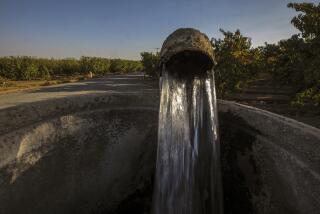CALIFORNIA COMMENTARY : Look Beyond the Current Drought : Now is the time for permanent changes that would adjust supplies to our increasingly urban reality.
- Share via
Next to the state’s $10-billion budget deficit, Gov. Pete Wilson’s most pressing problem this year likely will be the five-year drought that threatens to disrupt both the economic and environmental health of this state.
If the governor wants to have a lasting impact on California water policy, I urge him to view the drought crisis as not only an immediate challenge, but a long-range opportunity: a challenge to each of us to better use water and an opportunity to change the way we think about water.
It would be short sighted to view periodic droughts as the only water problem we have in the state. And it would be likewise short-sighted to suggest only emergency steps to face this drought.
Frankly, water policy is a contentious issue that most governors prefer to avoid. Gov. Edmund G. (Pat) Brown reached the last real consensus on water in 1960, when he got voter approval (a less than overwhelming 51% of the vote) for the State Water Project; his son, Edmund G. (Jerry) Brown Jr., got the Peripheral Canal through the Legislature in 1980 only to see it blown apart by the voters in 1982, and Gov. George Deukmejian essentially hid from the water issue after his scaled-down Peripheral Canal got hammered in the Legislature in 1984.
But Wilson’s initial statements the creation of a drought emergency task force and a threat to impose the equivalent of “drought martial law”--means that he’s willing to deal with the crisis. He should be applauded for this.
In the next few weeks the governor may need to force Draconian water cuts on all Californians--cities, farms and industry, north and south--to ensure that there’s enough water this year (and next) for people to maintain life. It will be painful--personally, economically and environmentally--but it will be necessary.
In addition, he should consider these steps for the long term:
--After water conservation and water recycling get us through this current drought, we can’t afford to go back to wasteful ways when the rains return. Conservation and recycling, essential in a drought, are necessary over the long run to meet the water needs of a growing state. Most short-term drought responses must become permanent, if perhaps less severe.
Just 20 years ago, for example, energy experts said that we’d need a string of nuclear power plants along the coast if we were to satisfy our energy needs into the 21st Century. But a series of energy crises shook us away from the “build, build, build” mentality in energy, and today we’re able to satisfy the growing energy demands of this state with greater efficiency and conservation.
What we need today in California is a revolution in water policy similar to the revolution we’ve witnessed in state energy policy.
--We need to be honest: While urban areas, north and south, can and should do a better job of managing their water supplies, the single most important fact of water use in California is that agriculture uses 85% of the state’s water. Regardless of how much water urban dwellers save, real water savings can best be had from farms. If better use of water on the farm requires a big slug of money from urban areas, Wilson should encourage it.
--Voluntary, free-market water exchanges between agricultural and urban areas must be encouraged and promoted. The governor asked the state’s water bureaucracy to do just that, and he should make the request permanent.
--We need to promote rational and environmentally sound water development projects that will help us through future droughts. Two such projects, the Los Banos Grandes Reservoir and the Kern County Water Bank, will allow us to store water in wet years. When completed, they will represent a billion-dollar investment in our water future.
We’ll survive this drought. It likely will take more personal sacrifice and greater local conservation efforts than we’ve seen. But if we’re to get through the next drought, we need to make dramatic changes in the way we manage, allocate and distribute water in this state. If we do, we’ll have better control over our limited water supply and the environment will be better off for it, too.
More to Read
Sign up for Essential California
The most important California stories and recommendations in your inbox every morning.
You may occasionally receive promotional content from the Los Angeles Times.













